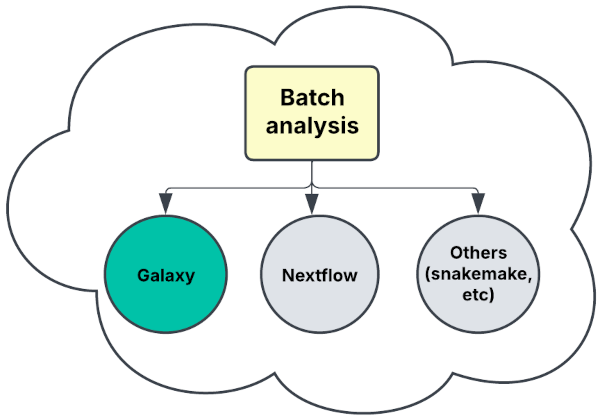Cloud based batch analysis
Prerequisites
Before starting this lesson, you should be familiar with:
Learning Objectives
After completing this lesson, learners should be able to:
Understand how to leverage cloud computing platforms, such as Galaxy, for efficient bioimage batch analysis
Motivation
Bioimage analysis requires significant computational power, making local processing inefficient and time-consuming. By leveraging cloud-based batch processing, researchers can scale their analyses, automate workflows, and handle imaging data with greater efficiency.
Concept map
Figure

Activities
In this exercise, we will build workflow using different batch analysis platforms
Show activity for:
Galaxy
To build a batch analysis workflow in Galaxy, we will use this tutorial. We will not repeat the steps but instead just describe the steps needed to run this workflow.
We will use the Galaxy’s Training Infrastructure as a Service(TIaaS) in the Galaxy EU instance for this course.
- Access the Galaxy
- Go to https://usegalaxy.eu/join-training/tim-bioimage-tools/ and join the training group. By joining the group, your Galaxy jobs are submitted to a special queue for fast execution.
- You could also go directly go https://usegalaxy.eu without joing the group. This way your Galaxy job will be in the public queue.
- Register an account in usegalaxy.eu if you are using it.Some tools are only available for registered users.
- Once you get to the Galaxy main page, on the left pane is the tool menu,where you will find all tools available in Galaxy EU.
- You could also search for a particular tool using the search box on top.
- Now we will build a workflow basede on this tutorial.
- Complete Steps 1 to 11, by the end of Step 11, we will have data ready in our Galaxy History.
- Click the
Workflowitem on the Galaxy menu, this will open an empty workflow page where we could start building our workflow in Galaxy.- Share Galaxy workflows
- After completing all the steps in the tutorial above, you will have a workflow in Galaxy. But what if you want to share it with others to make it reusable?
- Click
Workflowon the left side of the Galaxy screen. All available workflows under your account are listed in the main panel.- Find the workflow you want to share, and click the
Sharebutton.- By default, the workflow is only accessible to the the users listed under
Share Workflow with Individual Users.- To grant access to additional users, enter their email addresses in the provided text box and click
Save. These users will then see the workflow underWorkflow shared with mein their own accounts.- To generate a shareable URL that allows anyone with the link to view and import the workflow, toggle
Make Workflow accessibleat the top section.- If you want to make the workflow publicly available - so it appears in
Public workflowsand is searchable by anyone - toggleMake Workflow publicly available in published workflows.- Import/Export Galaxy workflows
- Currently the workflow is in the Galaxy EU instance, but what if we need to move it to another instances?
- Log in to the Galaxy EU and click
Workflowsin the left menu.- Find the workflow you want to transfer.
- Click
Download workflow in .ga format. This will download a.gafile to your host computer. You can then use the file in several ways as listed below. In this exercise, will will focus on importing it to another instance.
- Import it to another Galaxy innstance.
- Upload it to workflowhub.eu
- Publish it to Zenodo and obtain a DOI.
- Log in to another Galaxy instance, such as usegalaxy.org
- Click the
Workflowsin the left menu.- In the top right corner of the centre pane, click
Import.- If your
.gafile has an accessible URL, paste it intoArchived Workflow URL.- If your
.gafile is stored on your computer, clickBrowseunderArchived Workflow File, and select your file.- Click
Import workflowto complete the process.
Nextflow
Follow-up material
Recommended follow-up modules:
Learn more: